Millions of years ago, before North Dakota became a state, most of its parts were covered by a sea home to numerous fish, corals, conodonts, and brachiopods. That was between the Paleozoic and Permian Eras; no Precambrian fossils are known from the state. The seas dried up and were later replaced by subtropical swamps in the Cenozoic. Glaciers entered some parts of the state in the Ice Age. During this time, mastodons and mammoths roamed the local woodlands.
Most animals that lived during these eras became extinct due to climate change and other factors like insufficient food supply and predation. Let’s explore the 8 extinct animals that lived in North Dakota.
8 Extinct Animals That Lived in North Dakota
Unfortunately, no complete dinosaur fossil has been discovered in North Dakota. Nevertheless, this “Flickertail State” is well-known for its wide variety of prehistoric birds, marine reptiles, and several megafauna mammals.
Here are the 8 extinct animals that inhabited North Dakota.
1. Plioplatecarpus
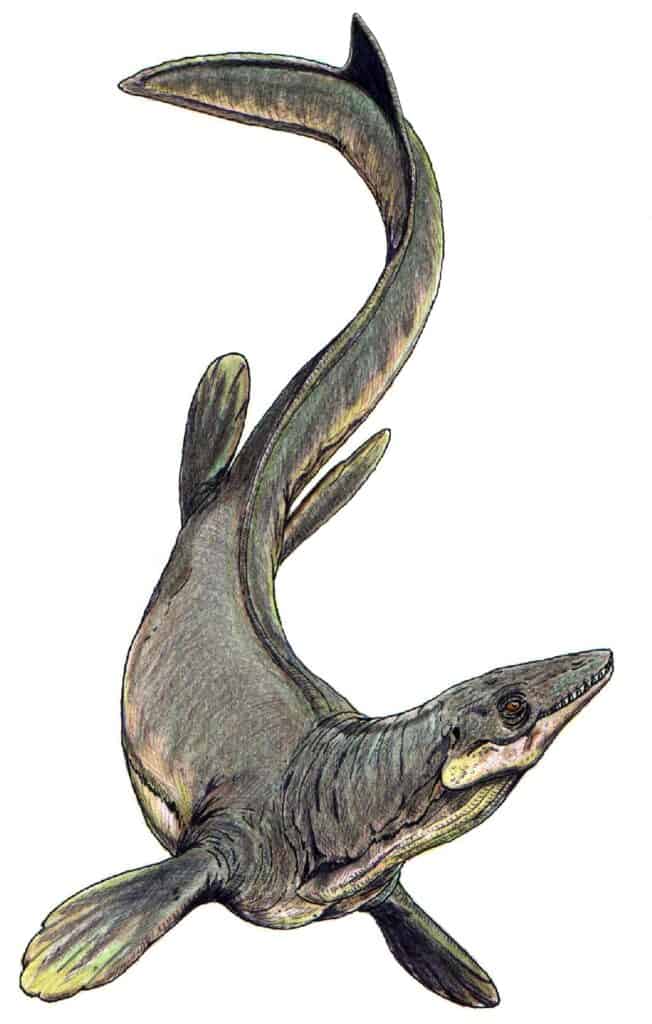
The first Plioplatecarpus fossil was discovered in Europe in 1882.
©Dmitry Bogdanov / CC BY-SA 3.0 – License
| Plioplatecarpus | |
|---|---|
| Kingdom | Animalia |
| Phylum | Chordata |
| Class | Sauropsida |
| Order | Squamata |
| Family | Mosasauridae |
| Subfamily | Plioplatecarpinae |
| Genus | Plioplatecarpus |
| Living period | Late Cretaceous period, 73-68 million years ago |
Plioplatecarpus was one of the largest predators of the sea. It’s a genus of mosasaur lizards that lived in the Late Cretaceous period. Although it had a relatively short skull, its eyes were more prominent than any other mosasaur species. This creature grew up to a total length of 40 feet.
The first Plioplatecarpus fossil was discovered in Europe in 1882. It was relatively incomplete, but more fossils turned up later. In 1995, a nearly complete skull of Plioplatecarpus was found in North Dakota.
2. Triceratops
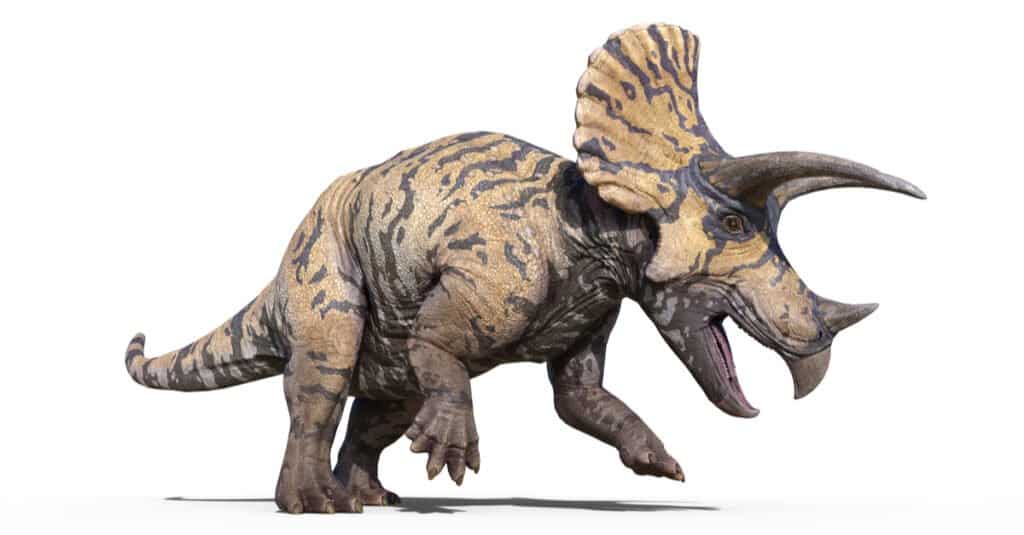
Triceratops was an herbivorous ceratopsid dinosaur that lived during the Late Cretaceous period.
©freestyle images/Shutterstock.com
| Triceratops | |
|---|---|
| Kingdom | Animalia |
| Phylum | Chordata |
| Clade | Dinosauria |
| Order | Ornithischia |
| Suborder | Ceratopsia |
| Family | Ceratopsidae |
| Subfamily | Chasmosaurinae |
| Genus | Triceratops |
| Extinct since | Late Cretaceous period, 68 million to 66 million years ago |
Bob the Triceratops was one of the most famous residents of North Dakota. It was a nearly complete specimen and was about 65 million years old. It was discovered in the Hell Creek Formation in North Dakota.
Triceratops was an herbivorous ceratopsid dinosaur that lived during the Late Cretaceous period. It wasn’t the only dinosaur that lived in North Dakota during this time, but it was the only one that left a nearly complete skeleton.
Triceratops had four large legs, three horns on the skull, and a substantial bony frill. It measured approximately 25 to 30 feet in total length and about 9 to 10 feet in height. It weighed between 12,000 and 20,000 pounds.
3. Champsosaurus

Champsosaurus is an extinct crocodile-like creature that lived during the Late Cretaceous and early Paleogene periods.
©D. Gordon E. Robertson / CC BY-SA 3.0 – License
| Champsosaurus | |
|---|---|
| Kingdom | Animalia |
| Phylum | Chordata |
| Class | Reptilia |
| Order | Choristodera |
| Genus | Champsosaurus |
| Living period | Late Cretaceous and Paleogene periods, about 145 million years to 66 million years ago |
Champsosaurus is one of the most common fossils in North Dakota. It’s an extinct crocodile-like creature that lived during the Late Cretaceous and early Paleogene periods. It had distinctive elongated and gharial-like snouts occupying almost half the skull’s length. The name Champsai was translated from the Ancient Greek word for “crocodiles” and sauros for “lizards.”
Its body was flat and streamlined and had rib-like bones in the belly. Most species grew to about 5 to 12 feet long. It inhabited freshwater environments where it likely preyed on fish.
4. Woolly Mammoth

The woolly mammoth is an extinct species of mammoth that lived between 800,000 years ago and 4,000 years ago.
©Dotted Yeti/Shutterstock.com
| Woolly Mammoth | |
|---|---|
| Kingdom | Animalia |
| Phylum | Chordata |
| Class | Mammalia |
| Order | Proboscidea |
| Family | Elephantidae |
| Genus | Mammuthus |
| Species | Mammuthus primigenius |
| Living period | Between 800,000 years ago and 4,000 years ago |
The woolly mammoth is an extinct species of mammoth that lived between 800,000 years ago and 4,000 years ago. It was one of the last in the line of mammoth species. This species measured about 11 feet at the shoulder and weighed up to 12,000 pounds. Like an elephant, a woolly mammoth also had long trunks and huge, curved tusks. Trunks were used for handling items and helping with foraging, while tusks were used for fighting.
One of the main differences between the woolly mammoths and modern-day elephants is that the woolly mammoths had much smaller ears. This was probably an adaptation to minimize the chance of frostbite.
5. The American Mastodon

Mastodons were very similar to mammoths, only that they had short, straighter tusks and cusp-shaped teeth.
©Sergiodlarosa / CC BY-SA 3.0 – License
| The American Mastodon | |
|---|---|
| Kingdom | Animalia |
| Phylum | Chordata |
| Class | Mammalia |
| Order | Proboscidea |
| Family | Mammutidae |
| Genus | Mammut |
| Living period | Late Miocene or late Pliocene – 11,000 years ago |
The American mastodons roamed the northernmost reaches of North America during the Late Pliocene up to their extinction at the end of the Pleistocene epoch, about 10,000 to 11,000 years ago. They were primarily forest-dwelling creatures. Modern skeletal reconstructions show that mastodons could attain a maximum weight of between 8.6 and 12 tons (17,200 to 24,000 pounds) and measured approximately 7 feet tall.
Mastodons were very similar to mammoths, only that they had short, straighter tusks and cusp-shaped teeth, well suited for chewing branches and leaves. It was inferred that mastodons were very social animals who lived in bonded groups called “mixed herds.” A few fossils of these mammals have been discovered in North Dakota.
6. Megalonyx
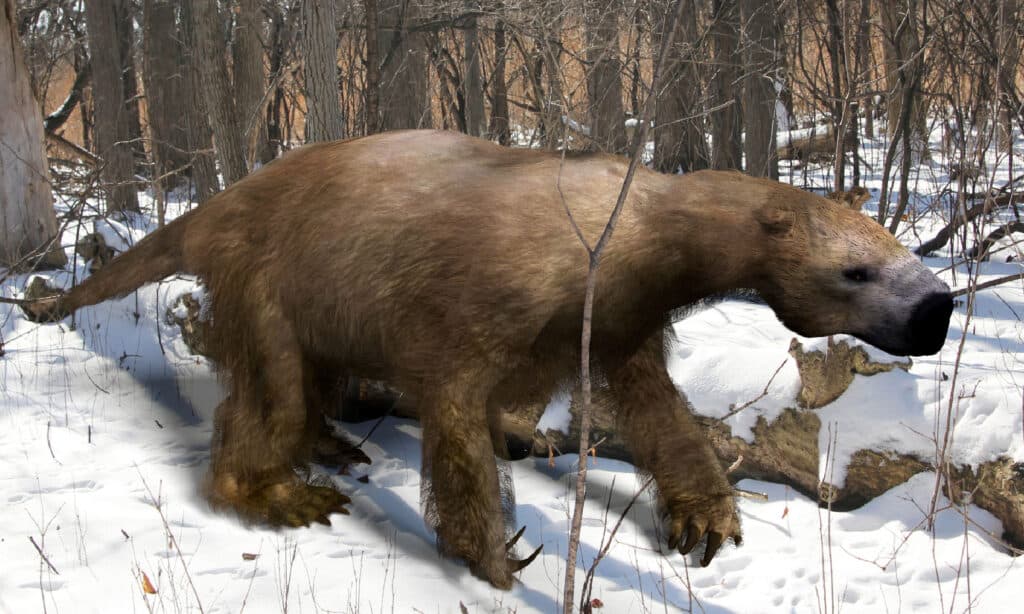
Megalonyx weighed approximately 2,200 pounds and measured about 9.8 feet in total length.
©iStock.com/Aunt_Spray
| Megalonyx | |
|---|---|
| Kingdom | Animalia |
| Phylum | Chordata |
| Class | Mammalia |
| Order | Pilosa |
| Family | Megalonychidae |
| Subfamily | Megalonychinae |
| Genus | Megalonyx |
| Living period | Pliocene and Pleistocene epochs (5 million to 11,000 years ago) |
Megalonyx is an extinct group of giant ground sloths that lived in North America during the Pliocene and Pleistocene epochs. This species became famous after being described by Thomas Jefferson a few years before becoming the United States’ third president. Surprisingly, Megalonyx remains were discovered in North Dakota recently, proof that this megafauna mammal had a more comprehensive range than was previously thought.
Megalonyx weighed approximately 2,200 pounds and measured about 9.8 feet in total length. It had a massive jaw, large peg-like teeth, and a blunt snout. Its hind limbs were flat to allow it to rear up into a semi-erect position while feeding on tree leaves. The forelimbs had three fully developed claws for tearing off branches and stripping leaves.
7. Megacerops
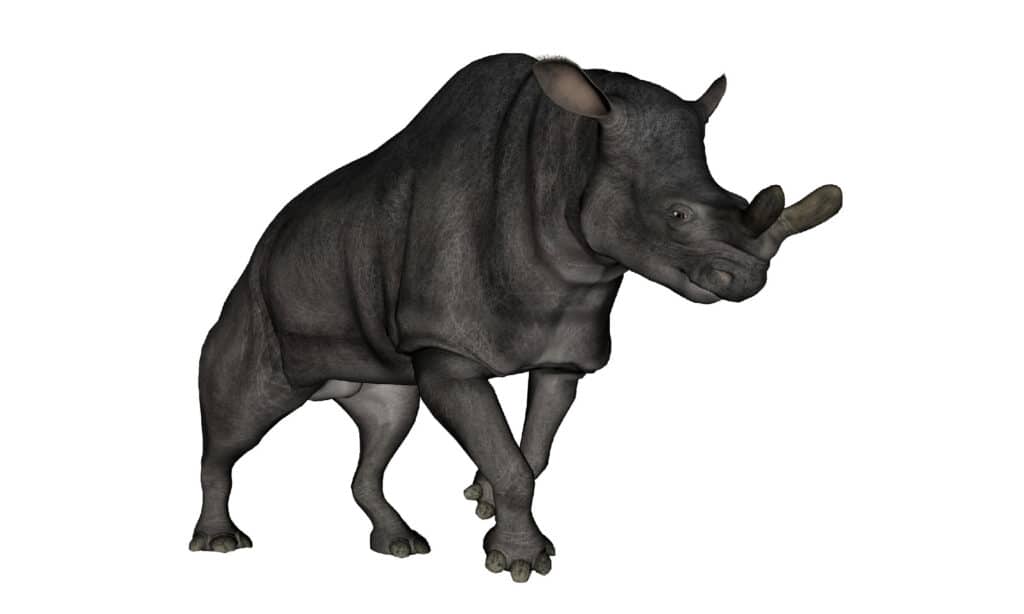
Megacerops was one of the largest rhinoceros-like megafauna mammals that lived during the Late Eocene epoch.
©iStock.com/Elenarts108
| Megacerops | |
|---|---|
| Kingdom | Animalia |
| Phylum | Chordata |
| Class | Mammalia |
| Order | Perissodactyla |
| Family | Brontotheriidae |
| Subfamily | Brontotheriinae |
| Genus | Megacerops |
| Living period | Late Eocene epoch – 38 to 33.9 million years ago |
Megacerops also goes by the names Brontops, Bronthotherium, and Titanops. It was one of the largest rhinoceros-like megafauna mammals that lived during the Late Eocene epoch, about 38 to 33.9 million years ago. Its lower jaw bone was discovered in the central part of North Dakota’s Chadron Formation. It was distantly related to modern horses and other odd-toed ungulates.
Megacerops weighed approximately 7,200 pounds and stood about 8 feet tall at the shoulders and body. It had Y-shaped horn-like protrusions, which were more prominent in males than in females. These horns were blunt on the ends. This could indicate they were social animals that butted heads, especially for breeding purposes.
8. Hesperornis
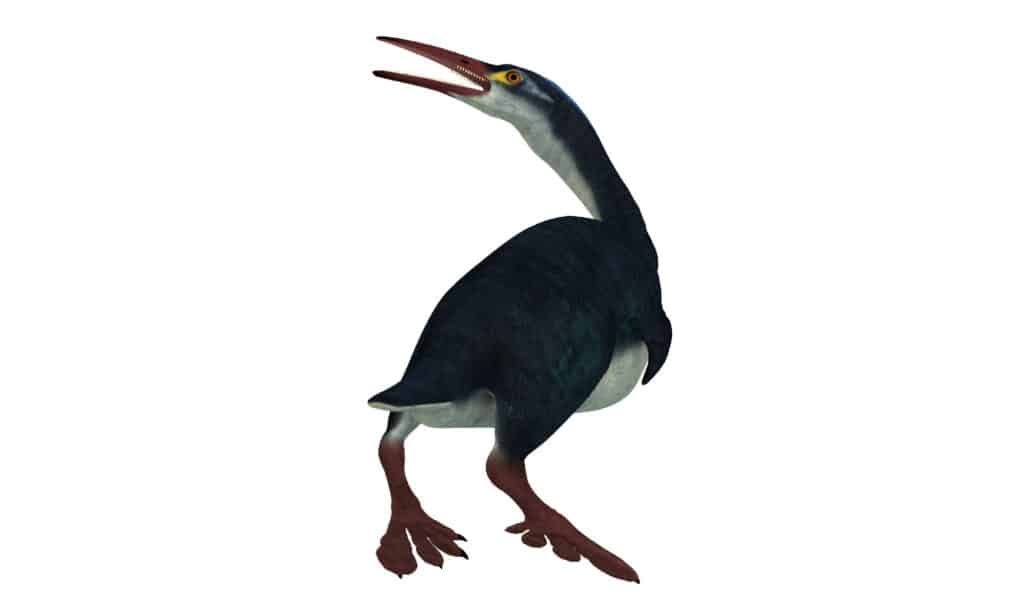
Hesperornis used its powerful limbs for swimming.
©iStock.com/CoreyFord
| Hesperornis | |
|---|---|
| Kingdom | Animalia |
| Phylum | Chordata |
| Clade | Dinosauria |
| Clade | Saurischia |
| Clade | Theropoda |
| Clade | Avialae |
| Clade | Hesperornithes |
| Family | Hesperornithidae |
| Genus | Hesperornis |
| Living period | Late Cretaceous period- 85 million to 65 million years ago |
Hesperornis was a large flightless bird from the Late Cretaceous period. This prehistoric bird was one of the instigators of the Bone Wars, a rivalry between paleontologists Edward Drinker Cope and Othniel C. Marsh in the late 19th century. Marsh accused Cop of stealing a crate of Hesperornis bones in 1873.
Since it did not have wings, Hesperornis used its powerful limbs for swimming. It could grow up to 5.9 feet in length. Hesperornis also had teeth and a beak, just like many other Mesozoic birds, such as Ichthyornis.
The photo featured at the top of this post is © iStock.com/Aunt_Spray
Thank you for reading! Have some feedback for us? Contact the AZ Animals editorial team.






